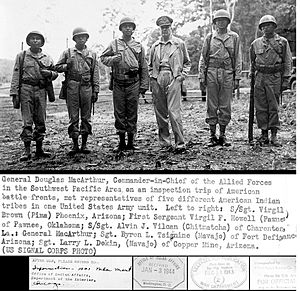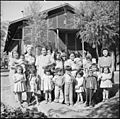Native Americans and World War II facts for kids

During World War II, many brave Native Americans joined the fight. About 25,000 Native Americans served in the military. This included men in the Army, Navy, Marines, and Coast Guard. Hundreds of Native American women also served as nurses. This was a huge number, with over one-third of all able-bodied Native American men aged 18 to 50 joining up. For some tribes, as many as 70% of their young men served.
The first Native American killed in WWII was Henry E. Nolatubby from Oklahoma. He died on December 7, 1941, when the USS Arizona sank during the attack on Pearl Harbor. Unlike some other groups, Native Americans served alongside white Americans. They were not placed in separate units. For many, joining the war meant leaving their reservations for the first time. It was a chance to experience the world outside their communities.
Contents
Life Before the War: A Time of Change
Before World War II, life on Native American reservations was often hard. There were not many jobs or ways to earn money. In 1939, the average income for Native American men on reservations was much lower than the national average. Many people had little formal education. Even those who finished high school found few job opportunities on the reservations. Most Native Americans who stayed on reservations worked as farmers.
Native Americans were not forced to join the military in World War I. This was because they were not considered full citizens of the United States yet. However, about 10,000 Native American men still volunteered to serve in that war.
When World War II began, Native American men were included in the draft, just like white Americans. Some were excited to join, while others were unsure. They wondered why the government could make them serve but didn't always give them full voting rights. Despite these questions, many Native Americans volunteered even if they weren't drafted.
Native Americans in Action: Fighting for Freedom
Native American soldiers were often seen as strong and brave warriors. Their fellow soldiers respected them greatly. They first fought in the Pacific War, which included battles against Japan. The first known Native American to die in the war was killed during the attack on Pearl Harbor.
Throughout the war, Native American men fought all over the world. They were part of many important battles. These included the Battle of Iwo Jima, where Ira Hayes was one of the Marines who famously raised the flag. They also fought in the invasion of Normandy, the liberation of the Philippines, and the Battle of the Bulge. Native Americans helped liberate Paris and Belgium. Some were even among the first Americans to enter Germany and helped free Berlin. They fought in places as far away as Australia, North Africa, and Bataan. Sometimes, white American soldiers mistook Native American soldiers for Japanese soldiers, which led to dangerous situations.
Serving in the war brought some benefits to Native Americans. They received honors, like special pow wows held before they left or when they returned home. They also learned new skills that could help them get better jobs later. The war also brought more money to reservations. The average income for Native Americans increased significantly by 1944. However, it was still much lower than the average income for white Americans.
Many Native Americans received awards for their bravery. More than 30 were given the Distinguished Flying Cross, a high honor for pilots. Over 200 military awards were given to Native Americans, not counting the Purple Heart. Pascal Poolaw is the most decorated Native American in the history of the United States Army. He served in World War II, the Korean War, and the Vietnam War. He earned many awards, including the Distinguished Service Cross and multiple Silver Stars and Bronze Stars.
One of the most famous contributions was the code talker project. In February 1942, a man named Philip Johnston suggested using the Navajo language as a secret military code. Johnston had grown up on a reservation and knew how complex the Navajo language was. By September 1942, the U.S. government had recruited hundreds of Native Americans who spoke both Navajo and English. Their job was to translate English messages into Navajo. This made it impossible for the enemy to understand.
These code talkers often worked behind enemy lines. They were praised for their courage and earned great respect from their fellow soldiers. When the code was finally revealed in 1968, it was the only oral military code that the enemy had never broken.
The code was very clever. It used special Navajo words that were hard to understand without training. For example, there were no Navajo words for military machines or foreign countries. So, they used existing Navajo words to describe them. Britain was called "between waters." A dive bomber was a "chicken hawk." A grenade was a "potato," and Germany was "iron hat."
In 2001, 28 Navajo Code Talkers were given Congressional Gold Medals. Most received them after they had passed away. Their story has been told in many books and films, including Windtalkers (2002). There was even a Navajo Code Talker GI Joe action figure!
After the War: New Beginnings
After the war ended, things changed a lot for Native Americans. Many who served found themselves living in cities instead of on reservations. In 1940, only 5% of Native Americans lived in cities. By 1950, this number had jumped to nearly 20%. Some Native American servicemen and women faced challenges like post-traumatic stress disorder and finding jobs after returning home.
Gallery
-
Apaches assisting in the unloading of beds for Japanese internees at the Poston War Relocation Center on April 29, 1942.
-
Native American women as Marine Corps Reservists at Camp Lejeune in 1943. The women here represent the Blackfeet, the Potawatomi, and the Ojibwe.
-
Private First Class Ira Hayes, who was a Pima, preparing to parachute out of an aircraft in 1943.
-
Lieutenant Woody J. Cochran, a Cherokee Indian and bomber pilot, holding up a captured Japanese flag and Nambu pistol during the New Guinea campaign on April 1, 1943.
-
Dan Waupoose, a Menominee chief, training at Algiers, Louisiana, on August 24, 1943.
-
Lieutenant Ernest Childers, a Muscogee, being congratulated by General Jacob L. Devers shortly after receiving the Medal of Honor in 1944.
-
Hopi Indians at the Poston Center in September 1945, after it was turned over to the Colorado River Indian Reservation.
-
Dan Akee, a code talker from the Navajo Nation.
See also
- Apache Scouts - A division of the United States Army Indian Scouts
- Arizona during World War II
- Alaska Territorial Guard - A military reserve force known as the Eskimo Scouts
- Charles Norman Shay - A Penobscot Maine tribal elder who served in World War II both as a master sergeant and a certified medical technician
- Machita incident - A high-profile instance of resistance to the draft among Indians in southern Arizona
- Windtalkers - A film depicting Navajo code talkers during the war
- Native Americans in the American Civil War
- Code talker











